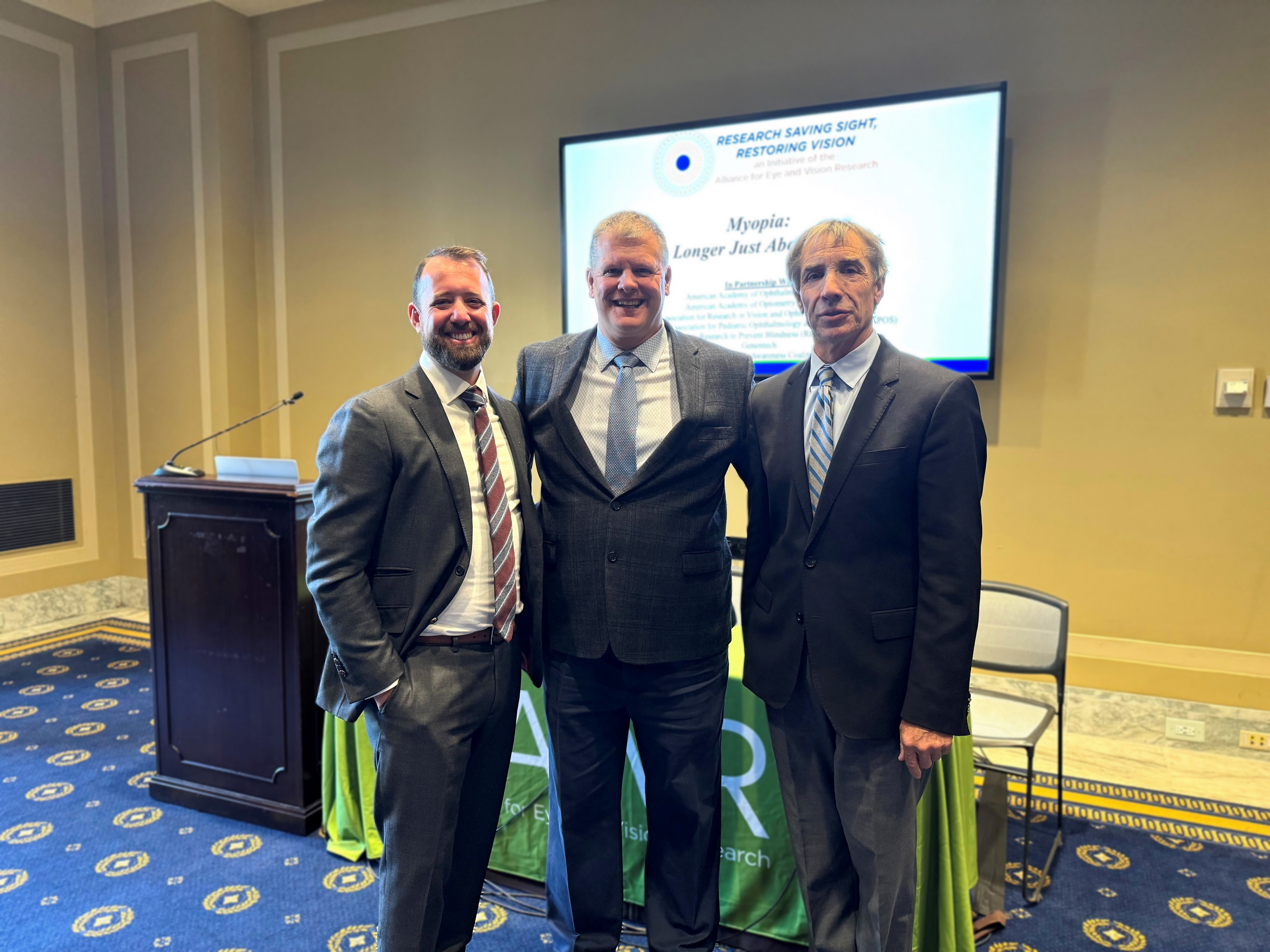AEVR Hosts Congressional Briefing Looking at Latest in Myopia Research and Treatments
 From left: AEVR Executive Director Dan Ignaszewski, Jeffrey Walline, OD, PhD (Ohio State University College of Optometry) and Michael X. Repka, MD, MBA (Johns Hopkins University School of Medicine) |
Myopia, also known as nearsightedness, is a prevalent vision condition affecting millions of people worldwide that is expected to impact more than half of the global population by 2050. As the prevalence of myopia continues to rise, researchers are diligently working to understand and manage this vision impairment effectively. To bring awareness to the importance of myopia management research, AEVR partnered with the American Academy of Ophthalmology (AAO) and the American Academy of Optometry (AAOptom) to conduct its Myopia Briefing on October 19 entitled Myopia: It No Longer is Just About Glasses. The briefing featured Michael Repka, MD, MBA, from Johns Hopkins University who serves as Medical Director for Government Affairs for AAO, and Paul Walline, OD, PhD, from Ohio State University who serves as the President-Elect for AAOptom, each of whom has made significant contributions to understanding research management of myopia.
Dr. Repka began by emphasizing the impact of and projected growth of high myopia as the prevalence of the impairment continues to grow. Additionally, he highlighted his research into the risk factors for myopia development and progression in children which include parental myopia, ethnicity, use of electronic devices, low light levels, low time outdoors, education, family income, high-pressure educational system, reading at close distance, urban environments, and sex with females seeing a higher incidence.
Dr. Repka also highlighted research that investigates the link between outdoor activities and myopia. The research finds that increased time spent outdoors may play a protective role against the onset and progression of myopia in children.
Following Dr. Repka’s introduction, Dr. Walline shared how he has focused much of his research on exploring strategies to slow down the progression of myopia, particularly in children. Some of the studies he highlighted investigated the effectiveness of multifocal contact lenses in controlling myopia compared to contact lenses that reshape the cornea (Orthokeratology) with data showing that both treatments work equally effectively and are safe in helping slow myopia progression and eye growth.
Dr. Repka then shared additional details about the effectiveness of spending time outdoors and the use of low-dose atropine eyedrops which have shown some promise and limited side effects but the conclusion is that more data is needed and the long-term outcomes of patients who have undergone treatment need to be clarified.
Finally, Dr. Walline shared additional research on the future of myopia control, including red light, spectacles, delaying myopia onset, and a broader combination of treatments. Dr. Walline shared that while red light myopia control has shown some positive benefits, it may also cause retinopathy and additional data is needed. With respect to spectacle control, Dr. Walline emphasized that spectacles still play a role in effective management and further emphasized how low-dose atropine eye drops may delay the onset of myopia. In looking at a combination of treatment methods, Dr. Walline explained that progress is being made but more research is needed to establish effective methods that may be available and emphasized many of these still need to go through the regulatory process for effectiveness and safety.
Both Dr. Walline and Dr. Repka's work underscores the importance of a multi-disciplinary approach to myopia management. Their research not only provides valuable insights into effective interventions but also emphasizes the need for continued collaboration between researchers, clinicians in optometry and ophthalmology, and educators to address the growing global burden of myopia.
As the prevalence of myopia continues to rise globally, the impact of myopia research extends beyond the laboratory, influencing clinical practice and public health strategies. With ongoing collaborative efforts and innovative research, the future holds promising prospects for enhanced myopia management strategies that can benefit individuals of all ages.
In addition to partnering with AAO and AAOptom with our featured speakers, AEVR also thanks member supporters of its Myopia briefing which included:
- Association for Research in Vision and Ophthalmology
- Research to Prevent Blindness
- American Association for Pediatric Ophthalmology and Strabismus
- American Optometric Association
- Global Myopia Awareness Coalition
- Genentech
The collaborative efforts between ophthalmology and optometry in myopia management represent a crucial synergy in addressing the increasing prevalence of nearsightedness worldwide. Recognizing that myopia is a complex vision condition requiring a comprehensive approach, professionals in both fields are pooling their expertise to develop integrated and personalized strategies. Ophthalmologists, with their medical training, contribute insights into the physiological aspects of myopia and potential medical interventions. Optometrists, on the other hand, bring expertise in vision correction and the application of optical devices. This collaborative approach facilitates a holistic understanding of myopia, combining medical and optical perspectives to tailor effective interventions for patients. By working together, ophthalmologists and optometrists can optimize the management of myopia, offering patients a range of options from pharmaceutical interventions to specialized lenses, thereby providing a more comprehensive and nuanced approach to myopia care. This collaboration holds the promise of advancing research, improving clinical outcomes, and ultimately enhancing the quality of care for individuals affected by myopia.